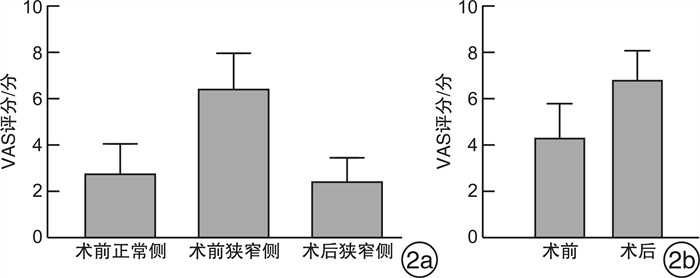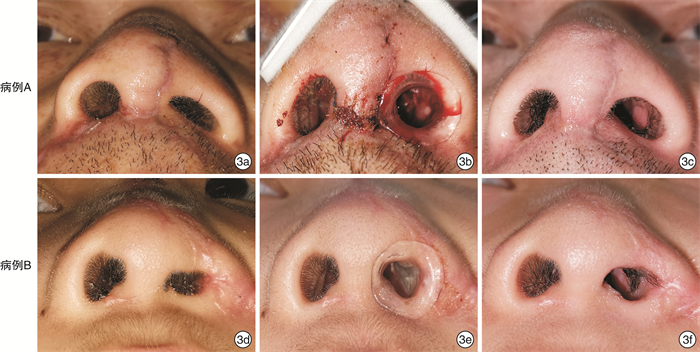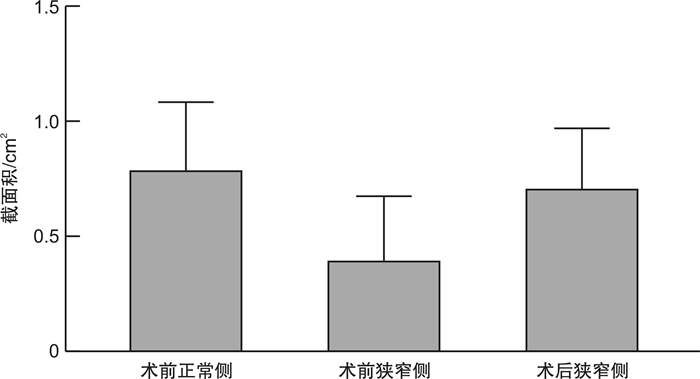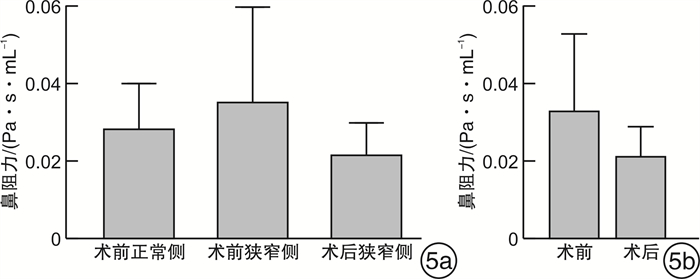Application of 3D printed nasal vestibular support in the treatment of anterior nostril stenosis
-
摘要: 目的 运用3D打印鼻前庭支撑器,评价其对鼻孔狭窄治疗后鼻腔通气功能和鼻孔形态恢复的疗效。方法 选择38例单侧外伤性鼻前庭区狭窄的患者,在术后予以3D打印鼻前庭支撑器扩张治疗,分别从主观评价指标、客观的局部形态结构参数和数值模拟鼻腔气流动力学参数等方面来评价术前和治疗后鼻腔局部形态和功能恢复情况。结果 鼻前庭支撑器扩张治疗后的患者鼻塞主观和鼻孔对称性满意度VAS评分均较术前有不同程度的改善;鼻孔形态学参数显示Δ长轴比值和Δ短轴比值在支撑扩张治疗后(0.09±0.09和0.16±0.13)均较手术前(0.21±0.20和0.28±0.21)明显减小(P < 0.01),并且狭窄侧的鼻瓣区截面积由术前的(0.40±0.27) cm2,增加到治疗后的(0.71±0.26) cm2,差异有统计学意义(P < 0.01);整个狭窄侧鼻腔鼻阻力也由手术前的(0.036±0.024) Pa·s/mL降低到治疗后的(0.022±0.008) Pa·s/mL,差异有统计学意义(P < 0.01),总鼻腔鼻阻力从术前的(0.033±0.020) Pa·s/mL降低到治疗后的(0.021±0.007) Pa·s/mL(P < 0.01);鼻腔气流温湿度调节功能参数[鼻腔加温效率(NWE)和鼻腔加湿效率(NHE)]结果显示,支撑扩张治疗后狭窄侧鼻腔的气流温湿度调节作用由术前的NWE狭窄侧(97.94±1.97)%和NHE狭窄侧(96.19±2.94)%下降到治疗后的NWE狭窄侧(95.92±2.8)%和NHE狭窄侧(94.55±4.17)%,差异有统计学意义(P < 0.01),对于整个鼻腔气流温湿度调节作用影响较小(P>0.05)。结论 3D打印鼻前庭支撑器用于前鼻孔狭窄患者的术后支撑扩张治疗能体现个性化治疗的优势并让患者获得较满意的疗效,并且使用个性化设计的3D打印鼻前庭支撑器能够使前鼻孔外形和鼻腔正常的通气功能均有较好的恢复,其临床应用前景较好。Abstract: Objective To evaluate the efficacy of 3D printed nasal vestibular support on the recovery of nasal ventilation function and nostril shape after nostril stenosis treatment.Methods Thirty-eight patients with unilateral traumatic nasal vestibular stenosis were selected and treated with 3D printed nasal vestibular support after operation. Subjective evaluation indicators, objective nostril local morphological and structural parameters, and nasal airflow dynamics parameters by numerical simulation were used. To evaluate the nostril morphological and nasal functional recovery after treatment.Results The subjective nasal congestion and nostril symmetry satisfaction VAS scores of the patients after nasal vestibular support treatment were improved to varying degrees compared with those before surgery; The nostril morphological parameters showed that the Δlong-axis ratio and Δ short-axis ratio were significantly decreased after nasal vestibular support therapy (0.09±0.09 and 0.16±0.13) compared with those before surgery(0.21±0.20 and 0.28±0.21) respectively(P < 0.01). And the cross-sectional area of the nasal valve on the stenotic side nasal cavity increased from(0.40±0.27) cm2 before operation to (0.71±0.26) cm2 after treatment(P < 0.01); The nasal resistance on the stenosis side nasal cavity also decreased from (0.036±0.024) Pa·s/mL before operation to (0.022±0.008) Pa. s/mL after treatment(P < 0.01), and the total nasal resistance was decreased from (0.033±0.02) Pas/mL before operation to (0.021±0.007)Pa. s/mL after treatment(P < 0.01); It also showed that NWE(nasal warming efficiency) and NHE(nasal humidification efficiency) on the stenotic side nasal cavity were significantly decreased after nasal vestibular support therapy([95.92±2.8]% and [94.55±4.17]%) compared with those before surgery ([97.94±1.97]% and [96.19±2.94]%) respectively(P < 0.01).Conclusion The 3D printed nasal vestibular support for postoperative support treatment on patients with anterior nostril stenosis can reflect the advantages of personalized treatment and allow patients to obtain satisfactory results, and the use of individually designed 3D printed nasal vestibular support can make the shape of anterior nostrils and nasal cavity normal ventilation function recover well, its clinical application prospect is worth looking forward to.
-
Key words:
- 3D printing /
- anterior nostril stenosis /
- numerical simulation /
- VAS score /
- nasal resistance
-

-
表 1 鼻孔、鼻前庭区形态学参数和鼻腔不同截面上平均流速比较
术前 手术和支撑扩张后 正常侧 狭窄侧 狭窄侧 鼻瓣区截面积/cm2 0.79±0.29 0.40±0.272) 0.71±0.265) 鼻瓣区气流平均速度/(m·s-1) 2.0±0.65 2.97±1.732) 1.81±0.685) 下鼻甲冠状截面的平均速度/(m·s-1) 前部 1.36±0.38 1.13±0.421) 1.25±0.394) 中部 0.76±0.19 0.59±0.291) 0.68±0.214) 后部 0.96±0.26 0.65±0.291) 0.84±0.254) Δ长轴比值 0.21±0.20 0.09±0.093) Δ蝮轴比值 0.28±0.21 0.16±0.133) 与术前正常侧比较,1)P < 0.05,2)P < 0.01;与术前比较, 3)P < 0.01;与术前狭窄侧比较,4)P < 0.05,5)P < 0.01。 表 2 鼻腔鼻阻力比较
鼻阻力 术前 手术和支撑扩张后 正常侧 狭窄侧 狭窄侧 鼻瓣区鼻阻力 0.015±0.009 0.0240±0.02052) 0.009±0.0062) 下鼻甲前缘鼻阻力 0.0178±0.011 0.0299±0.02481) 0.0126±0.0082) 下鼻甲前缘鼻阻力占单侧鼻腔阻力的百分比/% 61.20±19.04 73.47±21.11) 53.86±22.22) 狭窄侧鼻阻力(单侧) 0.036±0.024 0.022±0.0083) 总鼻腔鼻阻力(双侧) 0.033±0.020 0.021±0.0083) 与术前正常侧比较,1)P < 0.05;与术前狭窄侧比较,2)P < 0.01;与术前比较,3)P < 0.01。 表 3 鼻腔气流调节功能参数比较
术前 手术和支撑扩张后 正常侧 狭窄侧 正常侧 狭窄侧 单侧鼻腔 NEW单侧 95.29±2.87 97.94±1.971) 94.82±3.03 95.92±2.802) NHE单侧 91.52±3.98 196.19±2.941) 93.19±3.32 94.55±4.172) 总鼻腔 NWE总鼻腔 95.76±3.10 95.26±3.20 NHE总鼻腔 93.08±4.11 92.59±4.13 与术前正常侧比较,1)P<0.01;与术前狭窄侧比较,2)P < 0.01。 -
[1] Wang T, Chen D, Wang PH, et al. Investigation on the nasal airflow characteristics of anterior nasal cavity stenosis[J]. Braz J Med Biol Res, 2016, 49(9): e5182. doi: 10.1590/1414-431x20165182
[2] Thayer PS, Orrhult LS, Martínez H. Bioprinting of Cartilage and Skin Tissue Analogs Utilizing a Novel Passive Mixing Unit Technique for Bioink Precellularization[J]. J Vis Exp, 2018, 131: 56372.
[3] Zhang J, Wehrle E, Adamek P, et al. Optimization of mechanical stiffness and cell density of 3D bioprinted cell-laden scaffolds improves extracellular matrix mineralization and cellular organization for bone tissue engineering[J]. Acta Biomater, 2020, 114: 307-322. doi: 10.1016/j.actbio.2020.07.016
[4] Matai I, Kaur G, Seyedsalehi A, et al. Progress in 3D bioprinting technology for tissue/organ regenerative engineering[J]. Biomaterials, 2020, 226: 119536. doi: 10.1016/j.biomaterials.2019.119536
[5] Turnbull G, Clarke J, Picard F, et al. 3D biofabrication for soft tissue and cartilage engineering[J]. Med Eng Phys, 2020, 82: 13-39. doi: 10.1016/j.medengphy.2020.06.003
[6] Beredjiklian PK, Wang M, Lutsky K, et al. Three-Dimensional Printing in Orthopaedic Surgery: Technology and Clinical Applications[J]. J Bone Joint Surg Am, 2020, 102(10): 909-919. doi: 10.2106/JBJS.19.00877
[7] Hu X, Ji P, Wang T, et al. Combined orthodontic and orthognathic treatment with 3D-printing technique offers a precise outcome: A case report of two years followup[J]. Int J Surg Case Rep, 2021, 84: 105934. doi: 10.1016/j.ijscr.2021.105934
[8] Visscher DO, Gleadall A, Buskermolen JK, et al. Design and fabrication of a hybrid alginate hydrogel/poly(ε-caprolactone)mold for auricular cartilage reconstruction[J]. J Biomed Mater Res B Appl Biomater, 2019, 107(5): 1711-1721. doi: 10.1002/jbm.b.34264
[9] Issakhov A, Zhandaulet Y, Abylkassymova A, et al. A numerical simulation of air flow in the human respiratory system for various environmental conditions[J]. Theor Biol Med Model, 2021, 18(1): 2. doi: 10.1186/s12976-020-00133-8
[10] Radulesco T, Meister L, Bouchet G, et al. Functional relevance of computational fluid dynamics in the field of nasal obstruction: A literature review[J]. Clin Otolaryngol, 2019, 44(5): 801-809. doi: 10.1111/coa.13396
[11] Kimura S, Miura S, Sera T, et al. Voxel-based simulation of flow and temperature in the human nasal cavity[J]. Comput MethodsBiomech Biomed Engin, 2021, 24(4): 459-466. doi: 10.1080/10255842.2020.1836166
[12] Moniripiri M, Amjadimanesh H, Faramarzi M, et al. Numerical simulation of unsteady airflow in a nasal cavity for various sizes of maxillary sinus opening in a virtual endoscopic surgery[J]. Respir Physiol Neurobiol, 2021, 291: 103690. doi: 10.1016/j.resp.2021.103690
[13] Cherobin GB, Voegels RL, Gebrim E, et al. Sensitivity of nasal airflow variables computed via computational fluid dynamics to the computed tomography segmentation threshold[J]. PLoS One, 2018, 13(11): e0207178. doi: 10.1371/journal.pone.0207178
[14] Janović N, Ćoćić A, Stamenić M, et al. Side asymmetry in nasal resistance correlate with nasal obstruction severity in patients with septal deformities: Computational fluid dynamics study[J]. Clin Otolaryngol, 2020, 45(5): 718-724. doi: 10.1111/coa.13563
[15] Cal IR, Cercos-Pita JL, Duque D. The incompressibility assumption in computational simulations of nasal airflow[J]. Comput Methods Biomech Biomed Engin, 2017, 20(8): 853-868. doi: 10.1080/10255842.2017.1307343
[16] Xavier R, Menger DJ, de Carvalho HC, et al. An Overview of Computational Fluid Dynamics Preoperative Analysis of the Nasal Airway[J]. Facial Plast Surg, 2021, 37(3): 306-316. doi: 10.1055/s-0041-1722956
[17] 汪涛, 王珮华, 陈东, 等. 前鼻腔狭窄手术干预的数值模拟研究[J]. 中国中西医结合耳鼻咽喉科杂志, 2018, 26(5): 328-336. https://www.cnki.com.cn/Article/CJFDTOTAL-XYJH201805003.htm
[18] Siu J, Inthavong K, Dong J, et al. Nasal air conditioning following total inferior turbinectomy compared to inferior turbinoplasty-A computational fluid dynamics study[J]. Clin Biomech(Bristol, Avon), 2021, 81: 105237. doi: 10.1016/j.clinbiomech.2020.105237
[19] Hazeri M, Farshidfar Z, Faramarzi M, et al. Details of the physiology of the aerodynamic and heat and moisture transfer in the normal nasal cavity[J]. Respir Physiol Neurobiol, 2020, 280: 103480. doi: 10.1016/j.resp.2020.103480
-





 下载:
下载:




